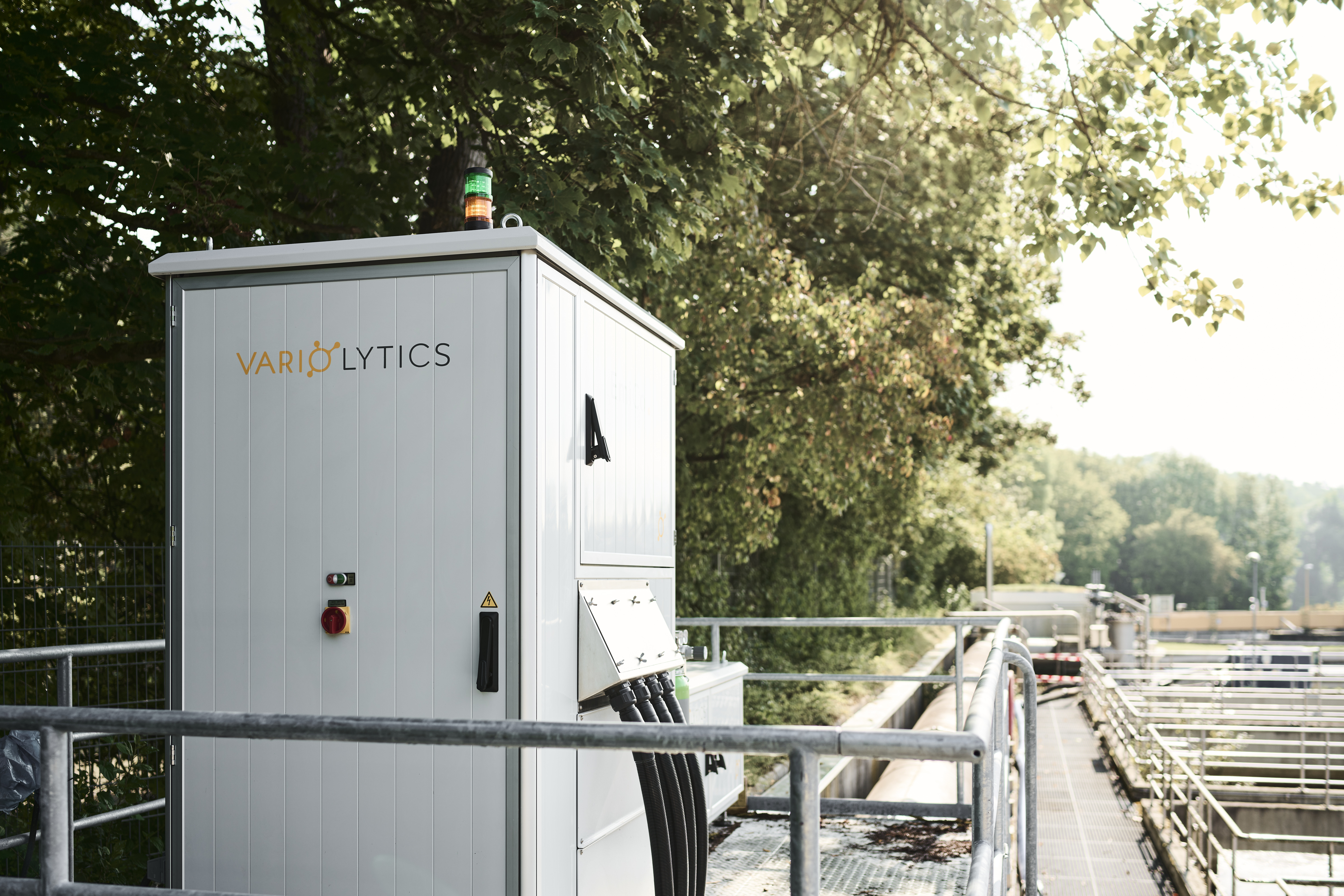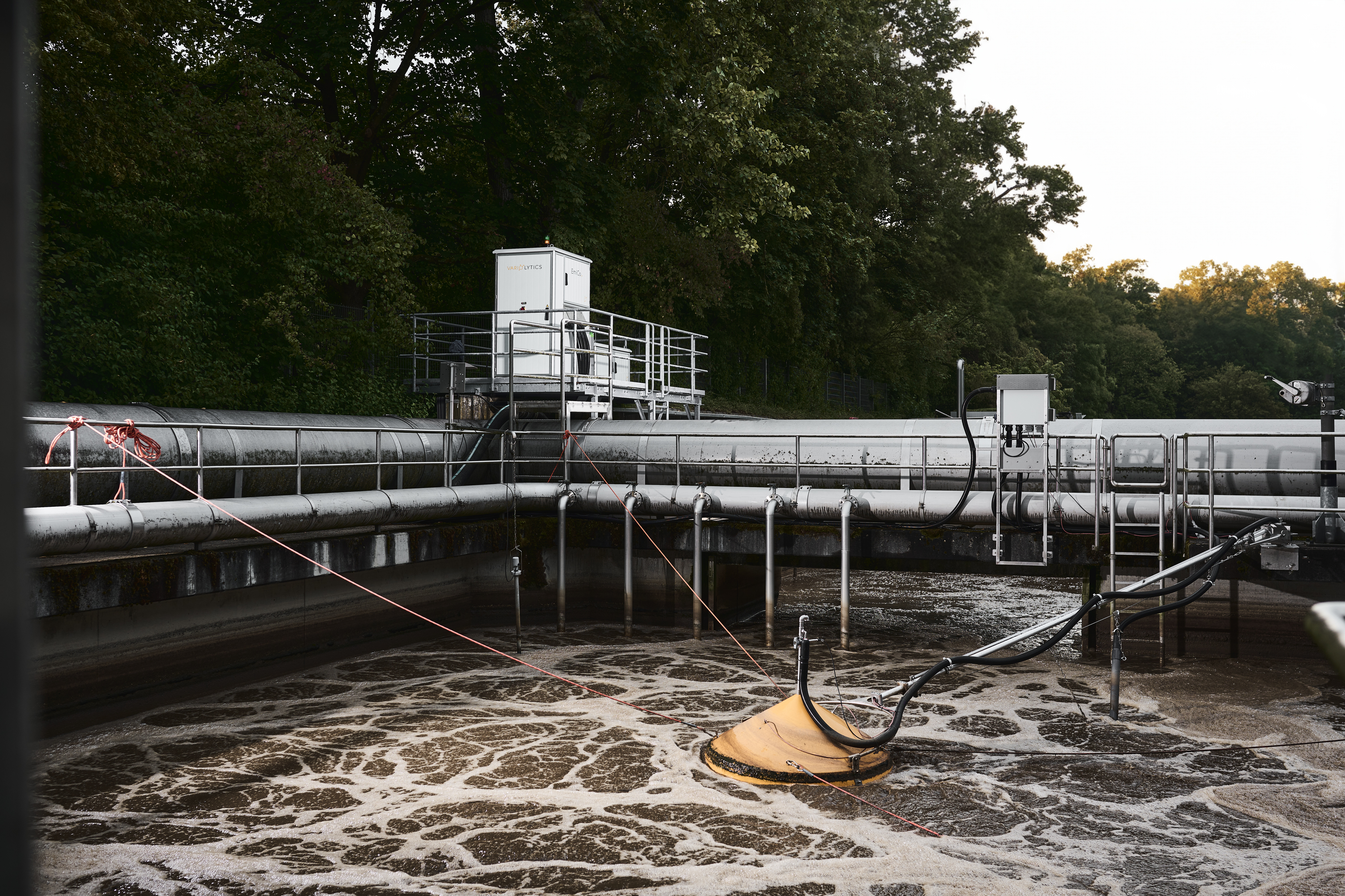Main navigation
Using AI to reduce greenhouse gases in wastewater companies
The wastewater industry is responsible for global greenhouse gas emissions equivalent to those of global aviation. The start-up Variolytics has found a way to significantly reduce greenhouse gases in wastewater treatment plants using the world's first real-time analytics. The patented sensor technology and AI-supported process optimisation offer multiple benefits to municipalities and the industry: in addition to reducing climate-damaging nitrous oxide, the system also helps to significantly reduce energy costs and resources.
Finding solutions for wastewater treatment plants plays an important role on the path towards climate neutrality because they account for around two percent of global CO2e emissions1). This is because biological wastewater treatment produces nitrous oxide (N2O) as a by-product, which is 273 times more harmful to the climate than carbon dioxide.
Wastewater as a climate factor - neglected so far
Little has yet been done about this issue: there is no system for monitoring and reducing greenhouse gases and there are no specific legal requirements for wastewater treatment plants. Variolytics wants to change this: the Stuttgart-based start-up has developed a globally unique system that simultaneously measures volatile substances from liquids and gases and links them with AI models and its own software. The patented platform technology for greenhouse gas reduction in wastewater treatment plants has now reached market maturity. "Our measuring devices and services enable industrial processes to be mapped and controlled more accurately, making them more efficient and sustainable," explains Dr. Matthias Stier, CEO and co-founder of Variolytics.
The focus is on nitrous oxide. The draft EU Urban Wastewater Treatment Directive2) addresses greenhouse gas emissions from wastewater treatment plants for the first time, and Variolytics provides evidence of nitrous oxide emissions and correlations. It is important to the company to be able to cite figures and back this up with a unique measurement system. What's more, the team has developed an efficient reduction path that can be implemented quickly and is also economically attractive.
Emission control system - revealing the living matter
Variolytics was founded in 2020 as a spin-off from the Fraunhofer Institute for Interfacial Engineering and Biotechnology IGB in Stuttgart. The engineers, natural scientists, computer scientists and economists involved in the start-up have a common mission: to make the invisible visible in order to detect environmental damage, among other things. The aim is to enable industrial customers to better understand and optimise their processes.

The start-up’s core project is a joint one called "Artificial intelligence for climate-neutral wastewater treatment plants (KIkKa)"3), which is funded by two Baden-Württemberg ministries. The system consists of a central emission control system, or EmiCo for short, that can directly measure the greenhouse gases produced during wastewater treatment. "We use high-resolution sensors to measure nitrous oxide, which is harmful to the climate, and artificial intelligence to control wastewater treatment processes in a climate-optimised manner," says Stier.
The crux of the matter when it comes to wastewater treatment plants is that the biological processes are highly complex and not yet understood in detail. Air is injected into the aeration tank to enable microorganisms to break down the impurities in the wastewater. If too much air is added, energy costs increase but the yield does not. If too little air is added, more nitrous oxide is produced. "Nitrous oxide emissions currently account for more than 70 percent of the CO2e footprint of a wastewater treatment plant. "We want to eliminate nitrous oxide altogether," Stier explains. As a process engineer and scientist at the University of Stuttgart and the Fraunhofer IGB, he has a wealth of experience. He is an expert in clarifying tanks. "With our system, it is possible for the first time to simultaneously measure all gas components in the gaseous and liquid phases, which allows us to monitor the metabolic processes of microorganisms and consequently the emissions in aeration tanks."
Perfect trio - patented measurement technology, software and AI
The company’s system is based on the patented EmiCo analyser, equipped with a quadrupole mass spectrometer for gas analysis and an inlet mass spectrometer with membrane and vacuum system for liquid analysis. The system measures all volatile components in real time with high detection sensitivity. Similar in some ways to helicopter parents, the analyser can simultaneously map the conditions at up to twelve points in several tanks containing microbes around the clock. This is achieved using proprietary software and a valve circuit that continuously alternates between measuring the liquid and gas phases.
But measuring and monitoring alone was not enough for the start-up: "Together with our partner, Dr. Jörg Gebhardt, we have found an even more efficient and sustainable way forward." The physicist and former managing director of a software company focused on process modelling has specialised in the intelligent optimisation of water and wastewater processes. "We combine physical performance data with AI models and algorithms." Wastewater treatment gets smart.
The world's first AI lighthouse project - 50 percent greenhouse gas savings and 20 percent energy savings

"Once installed in the aeration tanks, EmiCo autonomously collects data on the formation of gases," explains Stier. "The real-time values provide insights into the aeration status. The standard process parameters of the wastewater treatment plant are subsequently correlated with the nitrous oxide and methane values." Based on the data generated, the software controls and optimises the aeration system. "We use a validating measurement system, which is the only one of its kind on the market, to ensure that no harmful greenhouse gases are emitted. Previous systems can only measure either the gas or the liquid phase, but EmiCo can do both. And through optimisations, we also save energy and chemicals," says Stier.
The optimisation model is based on an artificial neural network (ANN) that learns from the data provided and is supported by classical mathematical methods. Once the prediction quality has been proven, the ANN can be used to support plant control, aeration, circulation and upstream treatment processes. Tools such as correlation analyses, statistical analyses and sensitivity diagrams contribute to the model calculations. The system is totally transparent, as Stier explains: "The model shows forecasts for expected process values so that the wastewater company can take targeted control measures. Our AI is used to provide recommendations for action."
When it comes to the risks of AI, Stier is clear: "Our AI depends on the intention and the underlying data. It helps to make processes safer and more efficient. As users, we check and take responsibility for the AI selection options throughout the process."
The results obtained nicely demonstrate how Variolytic’s philosophy can contribute to a sustainable future. Stier makes an interesting calculation: "The approximately 10,000 municipal wastewater treatment plants in Germany consume about 4,400 GWh of electricity per year and release about 4 million t of CO2. A nationwide deployment of our system could save 880 GWh of electricity and 2 million t CO2e per year, i.e. 20 percent electricity and 50 percent greenhouse gases."
Scaling and transferability for the 2030 climate target
EmiCo’s modular design enables the system to be integrated and expanded as required. A fluid process. The company is doing well, as shown by the awards it has received, which include the 2021 Stuttgart Innovation Award. This has enabled Variolytics to establish the most advanced process control system for water suppliers: from consulting, trial runs, installation and training to data acquisition, optimisation and support. The company’s system is installed in wastewater treatment plants in Ulm and Stuttgart-Möhringen, among others: in the one-year control phase, seasonal effects are mapped to build a comprehensive database, on which the AI-based system can be run autonomously.
The start-up is interested in more than just the financial side of the business. "It is important for us to make the know-how we have gained available to a broad community, from municipalities and industry to decision-makers. With our technology and the results achieved, we could create a separate emission factor for each type of wastewater treatment plant. The project would therefore be relevant for future legislation and contribute to the climate neutrality of municipalities."
This is a promising aspect with explosive potential in terms of meeting climate targets. "Our task is to develop a fast, scalable solution by 2030 with the aim of optimising the largest wastewater treatment plants in Germany." To achieve this, the team, as a hardware start-up, would like more support, for example through innovation loans or funds. "We would like to make our system transferable to any wastewater treatment plant and, in a next step, expand it to Europe as a whole," says Stier. The team is ready to take the next steps on the road to a climate-neutral future.
References/Footnotes:
1) CO2 equivalent emissions
2) Urban Wastewater Treatment Directive 91/271/EEC
3) The cooperative "Artificial intelligence for climate-neutral wastewater treatment plants (KIKKa)" project is funded by the Ministry of the Environment, Climate Protection and the Energy Sector and the Ministry of Economic Affairs, Labour and Tourism.